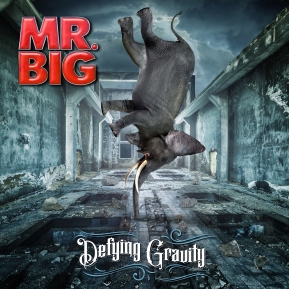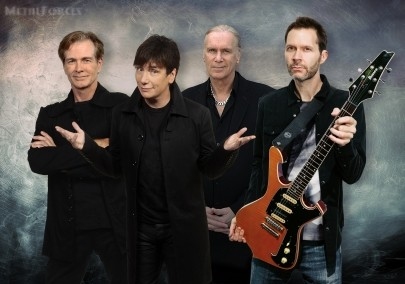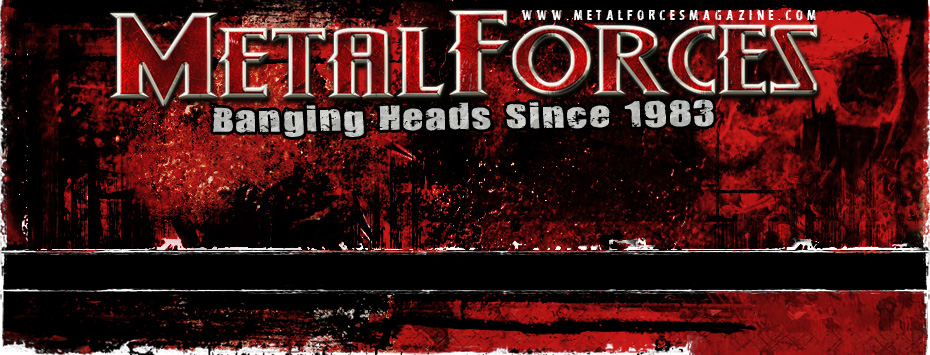
MR. BIG – Defying 2017
Anthony Morgan
July 2017
 Mr. Big (l-r): Paul Gilbert, Pat Torpey, Eric Martin and Billy Sheehan |
![]()
In attempting to realise July 2017 platter Defying Gravity – the ninth full-length studio album from Los Angeles, California-based hard rock outfit Mr. Big – members Eric Martin (vocals), Paul Gilbert (guitars), Billy Sheehan (bass) and Pat Torpey (drums), not to mention fill-in member Matt Starr (drums), were forced to mutually agree upon a block of time where all were collectively free.
“Everybody’s got their own projects going on, but we really wanted to do a Mr. Big record, and so we had to co-ordinate the schedules of everybody in the band, and also our producer,” begins Paul Gilbert. “We wanted to use Kevin Elson this time, who was the producer we used for our classic albums from the 80s and 90s. We found about a six-day period where everybody was free, and we thought ‘Is that enough time?’ We thought ‘We don’t know, but let’s just try hard,’ and so we all wrote songs and prepared as much as we could, and it was perfect. We got everything done, and got all of the basic tracks. Of course, after we were finished with that and we weren’t all together, Eric could keep working on his vocals, I did a couple of guitar solo overdubs on the road, and Kevin mixed the album. The majority of the stuff we did while we were together though, and it was nice to have that urgency. We knew that when we were in there, we had to work and we had to get it done. We had to make it great. It was a really enjoyable experience; I really had a great time of it.”
Some compositions were penned in solitude, while others were more collaborative. “I flew down to LA and got together with Pat and Billy a few times before the sessions started,” the axeman informs. “When Eric writes, a lot of times we’ll send him ideas that we’ve come up with, and then he’ll add his vocals to that, and continue writing from an idea we had started. Some songs came together that way while other songs were ones we had written on our own, and so it was really just a combination of everything.”
Paul was responsible for the authorship of the following tracks; ‘1992’, ‘Open Your Eyes’, ‘Mean To Me’, ‘Be Kind’, and ‘Nothing Bad (Bout Feeling Good)’. “Each song is sort of its own universe; they’re different from each other,” he reckons. “‘1992’ is the first one that comes to mind, and that one we’ve been playing live a lot. I think I like it because it’s got a lot of vocal harmonies, and that’s something I’ve always enjoyed about Mr. Big. Back when we did the Lean Into It record (March 1991), we had songs like ‘Green-Tinted Sixties Mind’, ‘Just Take My Heart’, and of course ‘To Be With You’. Those featured so many vocal harmonies and I’ve always loved that, so ‘1992’ has a lot of that, but it’s also a heavy song.
“It starts off with Billy and me doing some crazy instrumental stuff, and it’s got this big, heavy riff. It’s sort of a nice combination of all of those elements and of course lyrically it’s an interesting song, because it’s kind of an autobiography of the amazing experience we had in 1992, of having a number-one single (‘To Be With You’). So, that’s one of my favourites. We’ve been playing it live, and it’s been going over great. ‘Open Your Eyes’ is the opening track on the album, and again, I enjoy it because it’s got vocal harmonies that trade off of the Lean Into It vocals, and I think it’s got a pretty heavy guitar riff. There are a couple of cool solo breaks in it.
“The song is just about appreciating what goes on in your day, and for me, that’s being a musician. I use a line in the song about how if you do what you want, you’ll never work another day in your life, and I think every musician appreciates that. I’m so glad that what I do for my job is something that I would do no matter what. Don’t tell anybody, but I would do this for free because I love it.
“‘Be Kind’, this is a song where the older I’ve become and the more experiences I’ve had in my life, I think the more I’ve really realised that I’m not the only person in the world, and other people have their own situations and challenges. To kind of appreciate that and have empathy and be kind to people, because you never know what they’re going through at that time, or what they’ve had to go through to get to where they are. It’s really trying to feel what other people feel and being kind to them, so a pretty straight-ahead message. I also really like that song musically. It’s based on a lot of the blues and soul music that I’ve been listening to lately. I’ve been listening to artists like Ray Charles and Nina Simone, and getting into stuff that’s not strictly heavy metal, and learning new chords from other styles of music and new ways to play guitar.
“Let’s see… ‘Nothing Bad (Bout Feeling Good)’. That one definitely came from the lyrics first; trying to get a melody to fit the lyrics, and just letting the song build itself from there. It’s an interesting song, because the verse is very different than the chorus. That was probably the most challenging one for us to do in the studio, because it was almost like trying to do two songs in one, and make them flow smoothly back and forth between the two parts. I was really happy that Kevin Elson could help us work that out, because it was a tricky one.
 Paul Gilbert |
![]() “‘Mean To Me’, that was actually sparked by a drum idea. I’d heard a Christina Aguilera song, which was obviously a pop song, but the drum programming on that song reminded me of Scott Travis – the drummer I used to play with in Racer X, and of course he’s been playing in Judas Priest for years. It just reminded me of his double-bass style, and I thought ‘Well, that’s kind of interesting,’ that a pop artist would put these really fast bass drums in their pop song. I started kind of imitating it on my guitar, where I would play the kick-drum part on my lower strings – sort of a chunky thing – and then I would hit the chord stabs with the higher strings. I changed the notes around so it doesn’t sound like Christina Aguilera anymore – now, it’s my song. That was the original idea, though, hearing that and going ‘Wow, I can’t believe it. It sounds like Scott Travis playing this style in an ultra-pop song’.”
“‘Mean To Me’, that was actually sparked by a drum idea. I’d heard a Christina Aguilera song, which was obviously a pop song, but the drum programming on that song reminded me of Scott Travis – the drummer I used to play with in Racer X, and of course he’s been playing in Judas Priest for years. It just reminded me of his double-bass style, and I thought ‘Well, that’s kind of interesting,’ that a pop artist would put these really fast bass drums in their pop song. I started kind of imitating it on my guitar, where I would play the kick-drum part on my lower strings – sort of a chunky thing – and then I would hit the chord stabs with the higher strings. I changed the notes around so it doesn’t sound like Christina Aguilera anymore – now, it’s my song. That was the original idea, though, hearing that and going ‘Wow, I can’t believe it. It sounds like Scott Travis playing this style in an ultra-pop song’.”
Perhaps the influence of the likes of Ray Charles and Nina Simone will be audible in future solo material, even if in a subtle fashion. “Lately, overall, I’ve been into being a better improviser, and in a way I see improvising as being a combination of two things,” the musician observes. “One of the things is what your fingers will do on the guitar. Of course I’m a guitar player, so I’m thinking as a guitarist. I have to work within my physical limitations as to what my hands will do, and also the patterns I’m familiar with, and the places that my fingers are used to going. The other part of it is more pure improvisation though, and that’s what I hear in my head, and that’s a combination of just what I hear instinctively. I don’t know where my instincts come from – probably a lot of listening – but that’s a little more mysterious. It also comes from training my ear though, and I think listening to great improvisers and great melodies is a quick way to train that instinct.
“I tend to listen to a lot of singers, and actually one of my solo albums – Stone Pushing Uphill Man (August 2014) – was sort of a project in proving my melodic instincts by learning vocal parts on guitar. I just picked all of my favourite singers – everybody from Steven Tyler (Aerosmith) to James Brown, to Paul McCartney (The Beatles), to Eric Carmen… just all kinds of different styles – and tried to play those vocal parts. That’s really to me… The part of improvising is the most interesting thing to me at the moment, because I’ve trained my fingers so much that they can jump around the fretboard and do a lot of things, but it tends to be the same. Like any faster player, we’ve got our best licks, and they tend to be the same.
“I’ve found that as I’ve learned to improvise melodically, it seems like I can come up with a bigger variety of stuff. I kind of selfishly enjoy it more, because I’m in the moment so much. When you play something that your fingers do, you’re almost kind of living in the past. You play something you’ve spent a lot of time practising, but when you play something that you hear in your head, it might be inspired by something in the past, although the combination is something that can be brand new. As a player and as an improviser, that’s really exciting. I think that’s one of the reasons why I listen to a lot of singers, and I think that the singers who came from blues and from soul music are some of the best.”
Room for improvisation exists within a live setting, although said room is dependant upon the given track. “If I’m doing ‘To Be With You’, I’m not gonna be doing a lot of improvising because that solo is so based on the vocal melody that I just wanna keep it the way it is,” Paul reasons. “Most people have heard that a lot, but if we’re doing a song like… Well actually, even ‘1992’, which is a heavier song. I can still improvise on the solo – it’s different every night – or a song like ‘Undertow’ (from January 2011’s What If…), which again… To me, that chord progression is much more of a metal chord progression, but I play it different every night. The improvising that I study with blues and soul pays off, even when I play a metal song, the style in a way doesn’t matter so much. It more becomes just pure notes.”
A signature tune for Mr. Big, one would surmise that the songwriter has grown tired of continually performing ‘To Be With You’. “Oh, I love it,” he counters. “Like I said, I love singing harmonies. Before I even became a guitar player, I wanted to be a Beatle (laughs). That was my first dream as a musician, was to be like a Beatle. They were much more of a band that emphasizes the songwriting and the singing. Occasionally there’s a cool guitar riff, but if you listen to the way a Beatles record is mixed, the vocals are much louder than the guitar. Getting to do that was my original dream, so I love that as well. That’s the nice thing about being in Mr. Big, is I’m not only the guitar player. I’m the background singer, and so I get to do both of those things. Sometimes we even switch instruments and I get to be the drummer.”
Many a musician who dreamt of being a Beatle tended to have fantasized about being a specific member of the Fab Four. “Oh, any of them,” Paul clarifies. “I wasn’t really focused on which one. I just wanted to sing. I do remember watching Hard Day’s Night (1964), and there was a part where they were performing. The camera zooms in to members of the audience, and you can’t hear them because everybody’s screaming. You can’t hear the individuals, but you can read their lips. At one point there’s a girl, and you can read her lips. She’s screaming ‘Paul’ (McCartney), which of course is my name, and that’s a powerful thing. Just to see a girl screaming your name, even if you know it’s another Paul (laughs).
 |
![]() “I think that left an impression, but really it was the music. I just loved the music. At that time, I couldn’t watch that movie every day because it was before there were computers and laptops. There weren’t even VCRs then. I think I saw that once and it left a small impression, but the biggest impression was the album covers of the vinyl records, and just listening to them over and over again.”
“I think that left an impression, but really it was the music. I just loved the music. At that time, I couldn’t watch that movie every day because it was before there were computers and laptops. There weren’t even VCRs then. I think I saw that once and it left a small impression, but the biggest impression was the album covers of the vinyl records, and just listening to them over and over again.”
And as well, many a musician tends to harbour a favourite period of The Beatles’ musical career. “Really, I loved all of it,” the axe-slinger enthuses. “I tend to like the earlier stuff, just because of the energy of it. I get a sense that they were all really excited about what they were doing, and just kind of blown away by their success. Mentioning when we did our new album, we were able to do it in six days, and there was an urgency to that. I think when you look back at the history of the Beatles or the Beach Boys, or the pop bands of the 60s, they were all doing that same kind of thing. The Beatles’ first album (Please Please Me, March 1963), I think they did it in a day. They were doing things that are now considered to be so legendary, and if you look at the amount of time they spent, they were just writing their albums in their hotel room, and recording three songs in a day. Their schedule was insane. I think a lot of it was inspired by how incredibly successful they were, and just being excited about that. I love to hear that in music.”
Recording sessions for Defying Gravity took place at a Los Angeles studio across six days, sessions typically adhering to a given pattern. “We’d show up at the studio around noon” Paul lists. “Before then, I would get up at eight in the morning to try to finish up the verses of the song that I was writing. Maybe I had the idea for ‘Mean To Me’, but I only had the first verse. So, I’d get up and work on that a bit and try to finish up the lyrics, and just rehearse the arrangement a little bit because I knew I was going to have to show it to the band. Then I’d get to the studio by noon. At first we would probably work on the song that we had started the night before. Maybe we had rehearsed it a little bit, but now we had been able to sleep on it. We’d work on recording that, and that would take a few hours.
“Then I’d say ‘Hey guys, I wrote this new song before breakfast. Wanna check it out?’ (laughs). We’d listen to it, and try that a little bit, and start working with it. Then within a couple of hours, we’d have that one finished. Then we’d start on one of Eric’s songs, and then go ‘That sounded great. Let’s go to bed, and we’ll start up fresh with that tomorrow.’ Somewhere in there, we’d squeeze in lots of food and coffee.”
As referenced, Defying Gravity marks the return of Kevin Elson behind the production chair; Elson last twiddled the knobs for Mr. Big on January 1996 jaunt Hey Man. “I’m surprised it took us this long, because we had always loved working with him,” the performer remarks. “He’s busy. He’s a very sought after live sound engineer; he’s worked with everybody from Michael Jackson to Aerosmith, Lynyrd Skynyrd and Journey, and of course us. It was great to see him again. He always has a great ear and great ideas, and he’s really patient. With our schedules for this record, we didn’t have much time to be patient, but he wouldn’t give up on things. When I came in with my song ‘Nothing Bad (Bout Feeling Good)’, it didn’t work right away. We tried it, but we were like ‘I don’t know. The tempo might not be right’. He thought ‘Hey, it’s got a good melody. If it takes another hour, it’s alright,’ though. He would really have faith in the music, and keep working on it until the song worked.”
Schedules would need to align to pave the way for Kevin to produce further material from the quartet. “I’d like for him to, but we’ll have to wait for our next album to come around,” Paul notes. “We’ll have to see when we can find our next six-day opening (laughs), and who’s available.”
Kevin helmed production for Mr. Big’s June 1989 self-titled debut. “For me, I was really impressed that I could work with him,” the guitarist remembers. “The first time I met him, he was running sound for Michael Jackson, and he was the biggest artist in the world at that time. Here I am, I had just come out of Racer X – which was a successful club band in LA – but this was my first time working with a major label, and working with this legendary producer. He had done all of the big Journey records, and he had worked with Lynyrd Skynyrd. I think I wanted to be good, and I also wanted to be careful. I didn’t want to make him angry, or do something dumb (laughs), so I would just prepare a lot.
“And I’ll never forget… Back in those days, he would give me homework. I remember when we recorded ‘Daddy, Brother, Lover, Little Boy’. We recorded the basic track of the song, and I think this was before there even CDs – or, at least you couldn’t record your own CD. We were still working with cassettes, so he made me a cassette of the basic track. He said ‘Take this back home tonight, and write a solo for it. Have it prepared so when you come in tomorrow, we don’t have to waste time working out what you’re going to play.’ That worked out great. I spent the whole night working out a solo, and planning what I was going to play. Then when I came in, I could do it one take, and after I did that, he said ‘Let’s double track it.’ He really knew how to organise things, how to inspire us, and how to give good homework.”
Paul is arguably more Kevin’s equal in 2017 compared to 1989. “I was excited to show him how I play now,” he shares. “It’s been probably like 20 years since he has heard me play or at least heard me play in the same room, and my blues playing has gotten so much better since then. I know that that’s something that he loves. I was kind of excited to show him ‘Look, I can do this now,’ and the same thing with slide playing as I’ve gotten older. In the old days, I used to overdub a slide solo sometimes, and he would just look at me like ‘No, no. You’re not ready for that.’ This time, I overdubbed the slide thing, and he loved it. He said ‘Oh, that’s great.’ I really felt like I could impress him in ways that I couldn’t in the old days.”
Defying Gravity includes the involvement of drummer Pat Torpey, in spite of his Parkinson’s disease diagnosis. “Pat was like the drum producer,” the axeman divulges. “Him and Matt worked as a team to make the drum tracks happen, and that worked so much better than the last album. With the last album, we tried to programme everything. We of course wanted Pat to be involved, but with his physical challenges, he wasn’t able to play as strongly as he needed to. We thought that maybe he could play on electronic drums and record them with midi, and then he could edit that. It just became complicated. In the end it worked, but it just slowed it down. We never could have done it in six days, that’s for sure.
 Mr. Big (l-r): Pat Torpey, Eric Martin, Billy Sheehan and Paul Gilbert |
“For this, we had Matt who’s our touring drummer that comes out and tours, and of course Pat tours with us too. He’s there every day playing percussion, and he gets up on a song or two. We relied on the both of them to work together to make the drums in the studio though, so Matt was playing the kit. Pat would be the producer and have suggestions; about how the groove should go, and about what kinds of sounds to use. The goal was to make it sound like Pat Torpey, and there were the two of them that could do that. That was fantastic.”
In light of Pat suffering from Parkinson’s disease, fans wonder as to the man’s health status. “He’s doing great,” Paul replies. “He may be able to give you a few more details if you talk to him, but from watching him play and watching him on the road, he’s onstage with a big smile on his face and gets up on a song or two. I’m so glad he’s out with us; he’s part of the band, so it’s important that he’s there.”
Pleasurable it is to see that Pat isn’t letting Parkinson’s get the better of him. “I think it’s important for everybody in their life to not give up,” the musician offers. “Everybody has challenges in their life. Pat has a big one now, and I know that he has had his struggles with it. I think one of the biggest struggles was an emotional one; knowing that he wasn’t going to be able to do what he did before. For any musician, that would be really hard to deal with, but after having the support of his family and having the support of us, and us helping him, now every day he’s in a great mood. He’s contributing, and it’s great to see him not giving up. It’s inspiring to all of us.”
Paul has carved out a solo career away from Mr. Big, although solo endeavours aren’t currently on the agenda. “At the moment, there’s not much time,” he laments. “I’m busy with Mr. Big, and in-between that, I work on my Online Guitar School. I’ve done more than 5,000 videos now for my school. I’ll give it a plug; it’s with a company called ArtistWorks. I’ve got the Rock School. Before I had this interview with you today, I did a couple of videos for my students there, and I really enjoy that. As much as I’m the teacher, as the teacher I learn more than anybody. I love to learn, and in order to teach, I’ve got to know what I’m talking about, and so it makes me research music and it makes me practice. It makes me organise my thoughts about music, and it’s made me smarter and better. I continue to enjoy that a lot.”
Teaching how to play guitar, the composer often returns to a central piece of advice. “From teaching, it’s made me realise a lot of things that are important to me with style, and these are subjective things.” he views. “Every style has its own things that are important, but for me, I love 70s rock guitar; kind of starting with Jimi Hendrix and maybe ending with Van Halen, and all of the players in-between like Brian May (Queen), Robin Trower, Angus Young (AC/DC), Gary Moore (ex-Thin Lizzy), Michael Schenker (ex-Scorpions / ex-UFO), Uli Jon Roth (ex-Scorpions), Joe Perry (Aerosmith), Alex Lifeson (Rush), and all of the players from the 70s. That’s just my favourite time for rock guitar, and Jimmy Page (Led Zeppelin) of course – I have to mention him, and Pete Townsend (The Who).
“Those players, they came from the blues. Maybe they were second generation, or third generation blues players really, and because of that they had great vibrato. They could bend strings really well. When I listen to Mick Ralphs play that note in ‘Rock Steady’ (from June 1974 debut Bad Company), a Bad Company song, that’s one of the biggest things I want to get from my guitar – those beautiful bending and sustaining notes – and a lot of modern players aren’t into that. They’re more into big, chunky things. They want to play a chunky rhythm, and it’s more about percussion than it is about soulful bending. This is just my own style preference.
“I really want to share with players how much fun it is, and what a great sound it is to be able to bend a note well. In order to do that, you have to have a certain position with the guitar. You’ve got to hold it a certain way, and people aren’t doing that any more. As a teacher, it’s my mission to let people know you’ve got to have the guitar a little bit lower, and you’ve got to get your thumb over the top of the neck. If you do that, you’ll be able to grab the string, and you’ll have some strength with it, and you’ll have a fighting chance of bending it. When you hold it up high and play it like a classical musician though, you can’t bend it. You just don’t have the grip.”
The musicians whom Paul referenced arguably had moments where they shone in the tracks they performed on, but were part of a band and complemented their respective bandmates. “Oh, absolutely,” Paul responds. “Working with singers and writing great songs. It was hard for me to become an instrumental guitarist; I never wanted to do that. I wasn’t really a big fan of instrumental music, but I think I’ve come to love the guitar so much that I just try to sing with my guitar, and hopefully it doesn’t feel as much like instrumental music when it is. Yeah though, that’s why even with my solo stuff, I sing a lot. I just love that format.”
Defying Gravity was released on July 21st, 2017 via Frontiers Music Srl.
Related Posts via Categories
- SCOTTISH SICKNESS – A Report On The Scottish Death Metal Scene, Featuring BRAINBATH, PUTRID FATE And RANCID CADAVER (October 2022) | Features / Interviews @ Metal Forces
- LARVAE – Join The Hardcore Cult! (June 2022) | Features / Interviews @ Metal Forces Magazine
- TRENCH FOOT – Sacrificing Morals For Gory Obscenities (June 2022) | Features / Interviews @ Metal Forces Magazine
- L.A. GUNS – Trigger Happy (March 2019) | Features / Interviews @ Metal Forces Magazine
- CANCER – Crimes So Evil (November 2018) | Features / Interviews @ Metal Forces Magazine
- U.D.O. – The Tank Drives On (August 2018) | Features / Interviews @ Metal Forces Magazine
- SIEGE OF POWER – Bleeding For The Cause (August 2018) | Features / Interviews @ Metal Forces Magazine
- MOONSPELL – A Taste Of Live Eternity (August 2018) | Features / Interviews @ Metal Forces Magazine
- MONSTROSITY – Dark Matter Invocation (August 2018) | Features / Interviews @ Metal Forces Magazine
- SATAN – Five Magicians (August 2018) | Features / Interviews @ Metal Forces Magazine
|
|





